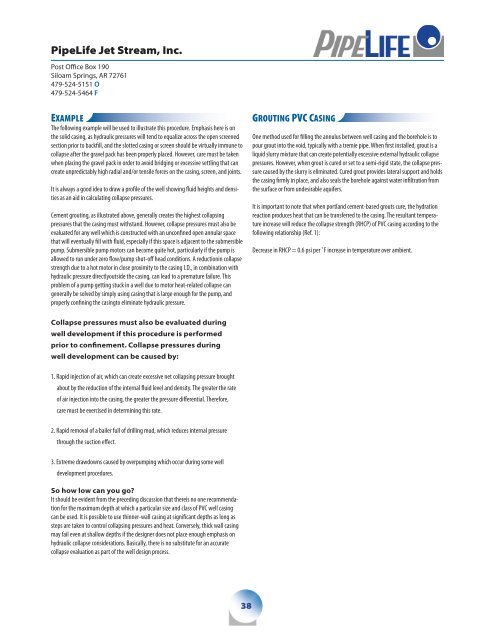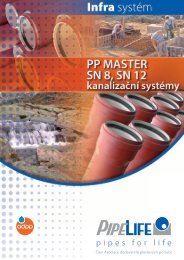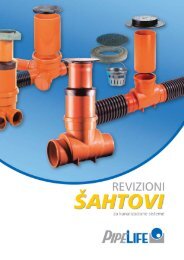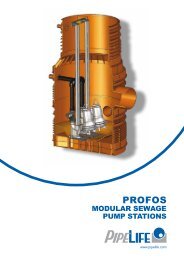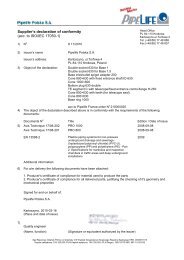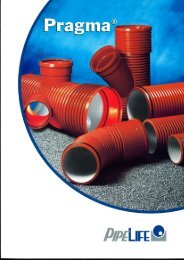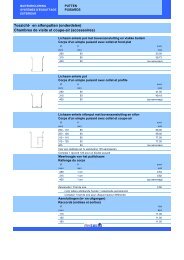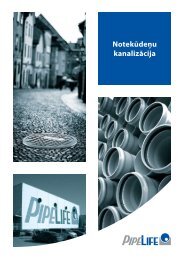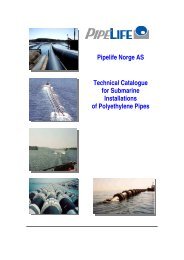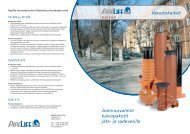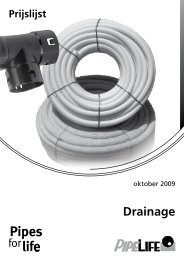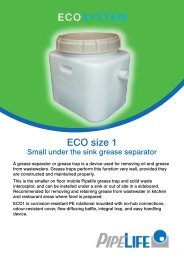PipeLife <strong>Jet</strong> <strong>Stream</strong>, <strong>Inc</strong>.Post Office Box 190Siloam Springs, AR 72761479-524-5151 O479-524-5464 FExampleThe following example will be used to illustrate this procedure. Emphasis here is onthe solid casing, as hydraulic pressures will tend to equalize across the open screenedsection prior to backfill, and the slotted casing or screen should be virtually immune tocollapse after the gravel pack has been properly placed. However, care must be takenwhen placing the gravel pack in order to avoid bridging or excessive settling that cancreate unpredictably high radial and/or tensile forces on the casing, screen, and joints.It is always a good idea to draw a profile of the well showing fluid heights and densitiesas an aid in calculating collapse pressures.Cement grouting, as illustrated above, generally creates the highest collapsingpressures that the casing must withstand. However, collapse pressures must also beevaluated for any well which is constructed with an unconfined open annular spacethat will eventually fill with fluid, especially if this space is adjacent to the submersiblepump. Submersible pump motors can become quite hot, particularly if the pump isallowed to run under zero flow/pump shut-off head conditions. A reductionin collapsestrength due to a hot motor in close proximity to the casing I.D., in combination withhydraulic pressure directlyoutside the casing, can lead to a premature failure. Thisproblem of a pump getting stuck in a well due to motor heat-related collapse cangenerally be solved by simply using casing that is large enough for the pump, andproperly confining the casingto eliminate hydraulic pressure.Grouting PVC CasingOne method used for filling the annulus between well casing and the borehole is topour grout into the void, typically with a tremie pipe. When first installed, grout is aliquid slurry mixture that can create potentially excessive external hydraulic collapsepressures. However, when grout is cured or set to a semi-rigid state, the collapse pressurecaused by the slurry is eliminated. Cured grout provides lateral support and holdsthe casing firmly in place, and also seals the borehole against water infiltration fromthe surface or from undesirable aquifers.It is important to note that when portland cement-based grouts cure, the hydrationreaction produces heat that can be transferred to the casing. The resultant temperatureincrease will reduce the collapse strength (RHCP) of PVC casing according to thefollowing relationship (Ref. 1):Decrease in RHCP = 0.6 psi per ˚F increase in temperature over ambient.Collapse pressures must also be evaluated duringwell development if this procedure is performedprior to confinement. Collapse pressures duringwell development can be caused by:1. Rapid injection of air, which can create excessive net collapsing pressure broughtabout by the reduction of the internal fluid level and density. The greater the rateof air injection into the casing, the greater the pressure differential. Therefore,care must be exercised in determining this rate.2. Rapid removal of a bailer full of drilling mud, which reduces internal pressurethrough the suction effect.3. Extreme drawdowns caused by overpumping which occur during some welldevelopment procedures.So how low can you go?It should be evident from the preceding discussion that thereis no one recommendationfor the maximum depth at which a particular size and class of PVC well casingcan be used. It is possible to use thinner-wall casing at significant depths as long assteps are taken to control collapsing pressures and heat. Conversely, thick wall casingmay fail even at shallow depths if the designer does not place enough emphasis onhydraulic collapse considerations. Basically, there is no substitute for an accuratecollapse evaluation as part of the well design process.38
PipeLife <strong>Jet</strong> <strong>Stream</strong>, <strong>Inc</strong>.Post Office Box 190Siloam Springs, AR 72761479-524-5151 O479-524-5464 FTemperature rise in cement-grouted wells is dependentupon three major factors:1. Grout thickness: Temperatures increase with grout thickness. Particular care musttherefore be exercised to avoid creating caverns in the formation during drillingwhich, when filled with cement slurry, could create excessive heat. It is also goodpractice to utilize centralizers to keep the casing centered in the borehole, whichwill prevent excessive grout build-up on one side of the casing.2. Fluid inside the casing: Water circulating inside the casing removes the heat ofhydration most effectively. Standing water inside the casing would be the nextmost effective means of temperature control. An air-filled casing will result in thehighest temperature increase for a given grout thickness. Circulating or standingwater inside the casing serves a dual purpose, providing temperature control and anoffsetting internal pressure.3. Type of cement grout: For portland cements, only standard Type 1 is generallyused with PVC, subject to the limitations discussed herein. Do not use concentratedquick-setting portland cement for wells cased with thermoplastic materials, due tothe excess heat that is released in a short period of time.In our example, using a 20°F temperature increase:Decrease in RHCP = 0.6 * 20 = 12 psiRHCP (<strong>SDR</strong>17) = 224 psi - 12 psi = <strong>21</strong>2 psiF.S. = <strong>21</strong>2/100 = 2.12In this example, the factor of safety is still above 2:1, even taking into accounttemperature effects.NOTE:All applicable state or local regulations governing grouting materials and procedures takeprecedence over the recommendations presented herein.IMPORTANT:As no two wells are the same, the information providedherein should be used by the drilling contractor and/ordesigner as reference material only. The designer and/orcontractor has responsibility for the specification of casingand for installation procedures. Need more information onprotecting PVC well casing against collapse? Contact PipeLife <strong>Jet</strong> <strong>Stream</strong> technical support at the phone numberlisted above.REFERENCES1. Kurt, Carl E., Johnson, Roy C., Warman, James C., “Engineering Performance ofThermoplastic Well Casings,” Water Resources Research Institute, Auburn University,Auburn, Alabama, July, 19802. Manual on the Selection and Installation of Thermoplastic Water Well Casing,National Water Well Association and The Plastic Pipe Institute, October, 1980.If calculations show that the hydraulic collapse factor of safety is falling below 2:1 or amodified target established by the engineer, one or more of the following correctiveactions must be adopted:• Use a heavier wall casing with a higher RHCP.• Grout in stages (unless prohibited by local regulations).• Pressure the grout through the inside of the casing instead of pouring grout intothe annulus with a tremie pipe. Further details on this procedure may be obtainedfrom the grout supplier. Note that while this operation virtually eliminates collapsingpressures at the bottom of the casing, a potentially high internal pressureis generally created at the top of the casing, which must be compared to the pipe’sshort-term pressure rating.• Use a bentonite grout. Cement/bentonite mixtures may also be an option. The useof bentonite grouts totally eliminates heat and significantly reduces slurry weight ascompared to standard portland cements. When properly used, bentonite makes anexcellent flexible grout, and is generally recommended for PVC casing. However, thecontractor is encouraged to consult with the bentonite supplier for any limitationson the use of this particular type of grout; in particular, the planned use of bentoniteshould be carefully evaluated to ensure that it will adequately shield the casing fromany ground movements or forces, and not create any excessive long-term compressiveloading on the casing due to its swelling properties.39
- Page 2: PipeLife Jet Stream, Inc.Post Offic
- Page 6 and 7: All PipeLife Jet Stream, Inc. produ
- Page 8 and 9: PipeLife Jet Stream, Inc.Questions
- Page 10 and 11: PipeLife Jet Stream, Inc.Pressure P
- Page 12: PipeLife Jet Stream, Inc.Post Offic
- Page 16 and 17: PipeLife Jet Stream, Inc.Post Offic
- Page 18 and 19: PipeLife Jet Stream, Inc.Post Offic
- Page 20 and 21: Purple PipeFor Use in Reclaimed Wat
- Page 22: PipeLife Jet Stream, Inc.Post Offic
- Page 25 and 26: PipeLife Jet Stream, Inc.Post Offic
- Page 27: PipeLife Jet Stream, Inc.Post Offic
- Page 30 and 31: PipeLife Jet Stream, Inc.Post Offic
- Page 32 and 33: PVC Slotted Well CasingSCH 210.035"
- Page 34 and 35: PipeLife Jet Stream, Inc.Post Offic
- Page 36 and 37: White PVC Schedule 80 TBE(threaded
- Page 41 and 42: PipeLife Jet Stream, Inc.Post Offic
- Page 43 and 44: PipeLife Jet Stream, Inc.Post Offic
- Page 45: PipeLife Jet Stream, Inc.Post Offic
- Page 48 and 49: PipeLife Jet Stream, Inc.POLYETHYLE
- Page 50 and 51: InksIodineIodine, in Kl 3%, Aq.Iodi
- Page 52: PipeLife Jet Stream, Inc.POLYETHYLE


